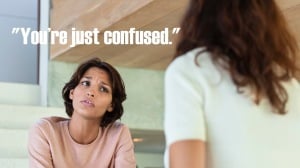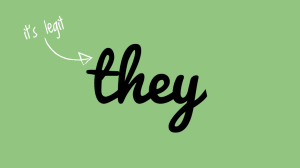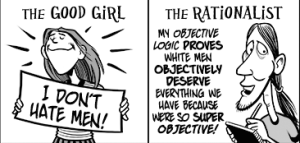
A person sits and frowns at someone facing away from the camera. The words “you’re just confused” on the image. Source: She Knows
What’s the number one misconception about non-binary people? It’s that we don’t exist.
In fact, if you Google “genderqueer is,” here are the top fill-ins that come up: “bullshit,” “a fad,” and “not real.” Awesome.
But despite the many Googlers doubting us, we do exist — in multitudes! It’s just that there are very few spaces where we can be ourselves.
Although many think that we don’t exist, ironically, there are still harmful stereotypes about us. Today, we’re going to look at ones that come from the United States.
Many people grew up being told that all people were either male or female. They never imagined that instead of two binary options for gender, there is a whole planet of possibilities out there.
Now — finally! — people are becoming more aware of non-binary genders, which you can learn more about here, here, and here.
This article in particular, though, is for people who already are aware that a world of gender exists and who want to know more about non-binary people.
Hopefully, it will also help you understand sexism in general more deeply. Because, as Julia Serano puts it, there are two main roots of sexism: One is the privileging of masculinity and maleness over femininity and femaleness, and another is non-binary oppression — or forced conformity to binary gender expectations.
While non-binary people are most directly oppressed by binary prejudice, revamping our conceptions around binary gender frees everyone.
Non-binary people are so marginalized that our genders do not occur to most people, except as a bad joke. We have no high-profile role models or political representation. Most people in the feminist community — and even many in the trans community — omit us in discussions of gender justice.
Yet our gender identities (or lack of gender) are at the heart of sexist thinking. Understanding non-binary oppression is a key piece of the puzzle for understanding gender-based oppression overall. Unlearning misconceptions and stereotypes about non-binary people is a great place to start.
But first, a note on language: Not everyone who is non-binary identifies as trans. Not everyone who isn’t solely male or female identifies as non-binary either. And agender people sometimes dislike the words non-binary and trans because they have the implication of gender within them. In this article, I will use the phrase “non-binary” as an imperfect umbrella term for anyone who does not solely identify as male or female.
Myth #1: You Are Trying to Be ‘Special Snowflakes’ (Or ‘This Is Just a Fad’)
This stereotype comes with the assumption that we’re spoiled and looking for attention by trying to be unique.
In actuality, this is simply our experience of gender, and it has nothing to do with “fads,” although I like to think we can be a fashionable bunch!
Common phrases that adhere to this stereotype include, “You can still wear whatever you want and be a girl/boy,” and “Just pick one already.”
When people say these things, they overlook the difference between gender identity and gender expression. Non-binary people can express our genders in any way that works for us, but at the end of the day, our gender identities still don’t fit solely into “male” or “female.”
For a non-binary person, choosing between being male or female is simply not an option.
The range of non-binary gender identities is nearly boundless — and so are the words we use to describe ourselves. Here is a list of some of those words. Our diversity, far from invalidating our identities, is at the heart of who we are.
Myth #2: You’re Just Confused
Being non-binary does not mean that we’re confused about our genders. It simply means that our gender is not solely male or female, or that we have no gender.
Underlying this myth is the idea that because others are often confused by us, there is no way that we could actually be sure about being non-binary.
There also is the assumption that if we’re confused, then it’s okay for people to decide how to refer to us.
However, there is absolutely nothing wrong with being confused about your gender! Confusion is completely normal and a part of many trans people’s process.
What is unacceptable, though, is invalidating people’s genders because they’re still figuring things out. No matter what, others should affirm and respect our genders.
Myth #3: You Are a New Concept
Non-binary people have been around in all societies for a very long time. In mainstream American society, we simply have received no societal space or attention until recently. This reasoning is often backed up by the thought that “if I haven’t heard of it until now, it must not have existed until now.”
In fact, many cultures across the world have words for genders that are neither or both male or female, and a number of cultures have specific spaces for them.
This map, although it employs problematic imperialist language at times, is a good starting point to learn more.
Being non-binary is a normal and natural way of being and experiencing gender (or being agender). And it has been since—uh—forever.
Myth #4: You All Fit on a Spectrum, from ‘Masculine’ to ‘Feminine’
Many people like to say that the binary gender system only allows us two colors, when really the full possibilities of gender exist as a whole range of color.
This analogy is more useful than “spectrum” because it allows for all genders to be measured not by the amount at which they “measure up” to the two most common gender identities and expressions, but simply by the way they just are.
Sometimes the spectrum analogy is helpful. For example, it’s useful when someone is trying to describe their gender in relation to binary gender identities and expressions, or if their gender feels relatable to those things.
But gender has so many more possibilities than that. For some people, “spectrum” is just too small of a concept.
In terms of gender expression, “masculine,” “feminine,” and/or “androgynous” are words that work for some non-binary people. But there are also so many more ways for non-binary people to express themselves and to experience gender.
This is why it’s important to assume you don’t know someone’s gender identity and to always ask how to refer to someone.
Myth #5: You’re Genderqueer? That’s So Political!
We don’t tell binary people, “Oh, you’re a man? That’s so radical!” or “You’re a woman? That’s a divisive stand to take!”
Even though being a trans or cis man or a trans or cis woman certainly has political implications, it is first and foremost recognized as a gender identity.
People seem to think that we’re non-binary simply to spread a political message about gender — or to “smash the binary” in an ideological sense.
In reality, we are simply trying to live our lives as ourselves.
Being non-binary is first and foremost about gender identity.
When so many people deny who we are, our very existence can be political. We are (often, not always) political because our identities are so marginalized.
But our actual genders (or agender status) are simply an innate part of us.
Myth #6: You Want to Destroy Gender
This myth asserts that we are invalidating binary trans and cis people’s genders. It also ignores that many non-binary people do have genders themselves.
And sure – some non-binary people hate the whole idea of gender and the gender system, and therefore do identify with the idea of destroying gender. After all, the binary gender system has oppressed us literally out of our lives and ourselves.
Usually, though, the conversation is about building space for a whole world of genders. It’s not about disallowing binary people, trans or cis, from having binary genders.
Instead of destroying gender, many of us simply want more options for gender — or the option to not have one at all. We want a world that has been unnecessarily and painfully restricted to be opened up, in full color. We are creating a world where gender is joyful for all who experience it.
Myth #7: Your Pronouns Are Ridiculous
Trans people often have to fight for people to use the right pronouns. In addition to this, many non-binary people also have to fight against ridicule of their actual pronouns. People’s incredulousness often goes back to the idea that we are asking for special treatment.
Like with any pronoun change, people also tend to focus more on how difficult it is to accommodate the change rather than on how to make this as easy as possible for the person transitioning.
When there are unfamiliar pronouns involved, this reluctance can grow even more quickly. But instead, the focus should be on respecting the needs of the person who is transitioning. It can be a learning curve to get non-binary pronouns right, but respecting everyone’s genders is important.
Whatever pronouns anyone uses (and there are so many possibilities!), those pronouns are an expression of who they are. Some people use all or multiple pronouns, and some people use no pronouns.
Using “he/him/his” or “she/her/hers” pronouns does not always mean that someone is actually male or female. This is why it is better to introduce yourself with the combination of pronouns you use rather than calling them “male” or “female” pronouns.
And some non-binary people who use gender-neutral pronouns are happy with someone using any or many gender-neutral pronoun options. Some are not, for a large variety of reasons. So please be sure that you are clear on what the non-binary people in your life need.
When someone asks for a pronoun change, it’s to become more comfortable and happy. There’s nothing ridiculous about that!
For a discussion of why it is important to respect all pronouns, please check out this article.
Myth #8: You Don’t Medically Transition
Trans people have long been subjugated by the mental health and medical care systems in order to get the care they need. Trans women have had to express in typically feminine ways in order to get treatment, and the situation has been similar for trans men.
Non-binary people weren’t even recognized by the WPATH Standards of Care until a few years ago, when finally the mental health community said that a variety of gender-related treatment can be medically necessary for non-binary people.
Now that the Standards of Care have been updated, non-binary medical transition is slowly becoming more accessible.
However, research on non-binary treatment options is practically non-existent, and the possibilities are very limited. Physical transition for trans people in general is hard to access and poorly researched. With non-binary people, this problem is multiplied.
Just as with binary trans people, not everyone who is non-binary medically transitions. Some people don’t experience physical dysphoria; some do not have options that work for them; some people simply don’t want to; some people have been denied access.
But it is true that some non-binary people can and do transition medically.
Myth #9: Non-Binary Equals Intersex
These are two different things. Like, entirely.
Being non-binary is about having a gender identity that doesn’t fit neatly into “man” or “woman.” Being intersex is about being born with a physical sex that isn’t classified as typically male or female.
This idea that intersex and non-binary people are the same comes from the insistence that our gender identities must “match” our sexes, and therefore that the sexes of non-binary people must not be male or female (and therefore, supposedly, intersex).
Reducing people to their body parts is a basic form of transphobia — and sexism in general.
In addition, some well-intentioned people try to problematize the gender binary by saying that intersex people’s existence demonstrates that “man” or “woman” aren’t the only two options.
This flawed logic does more harm than good, however. The existence of a variety of sexes is unrelated to the existence of a variety of gender identities. This is because our bodies do not determine gender identity, even if they often influence the way we experience it.
Myth #10: You Don’t Experience Trans Oppression
In fact, we suffer significant impacts of anti-transgender bias and in some cases, are at higher risk for discrimination and violence than our binary transgender counterparts, according to this groundbreaking 2008 National Transgender Discrimination Survey.
This is probably due to the fact that binary prejudice is common in both the trans and the cis communities, leaving us with very few safe spaces and support systems.
These statistics also might be affected by the fact that a proportionally higher amount of people of color identified as non-binary since racism greatly increases the risks a trans person faces.
This survey found that, compared with binary trans people, we have higher rates of physical and sexual assault, police harassment, and working in the underground economy.
Non-binary people also attempt suicide at a slightly higher rate even than the already ridiculously high rate for trans people in general. 43% of us have attempted suicide, and that is deeply connected to the challenges we’ve discussed throughout this piece.
It is hard to live in a world where we are told we don’t exist and where we are punished and silenced for being visible.
***
Given the especially high levels of oppression non-binary people face in nearly every category, it is imperative that non-binary people are one of the foremost voices in conversations on gender justice.
There are ways you can help.
The biggest way you can combat non-binary oppression in your daily life is by including non-binary people any time a relevant conversation about gender comes up.
Ensuring that people are aware of non-binary experiences will go a long way towards making the world a freer, glitterier, happier place for all of our genders — and for those who have none at all.
[do_widget id=”text-101″]
Adrian Ballou is a Contributing Writer for Everyday Feminism and a genderqueer writer, artist, activist, and educator. They graduated cum laude from the transmisogynistic Smith College in 2011, and they have spent the past several years doing youth development work both inside and outside the classroom. They particularly enjoy developing and delivering curriculum on social justice education and youth organizing. In their free time, they cook lots of food, sing songs, make art, and practice their Spanish, Hindi, and Urdu. Read their articles here.
Search our 3000+ articles!
Read our articles about:
Our online racial justice training
Used by hundreds of universities, non-profits, and businesses.
Click to learn more




















